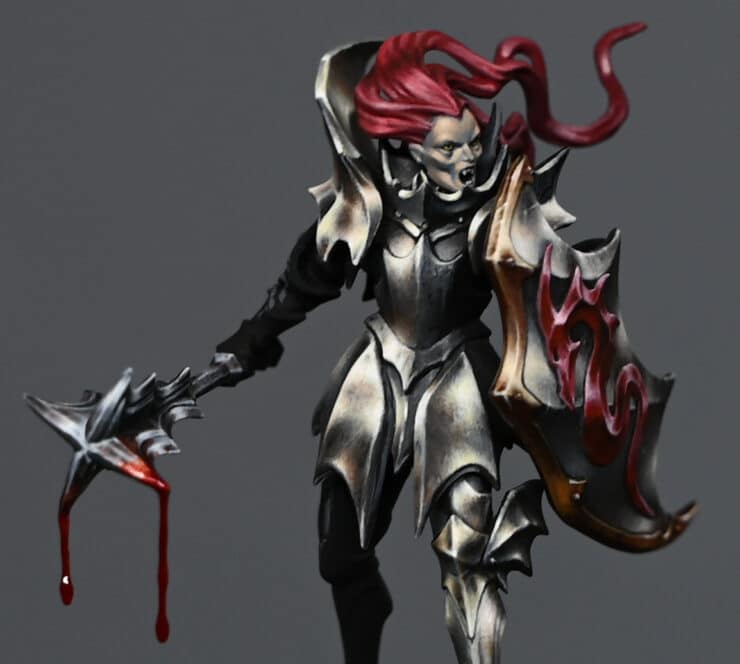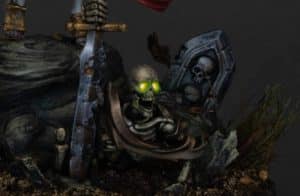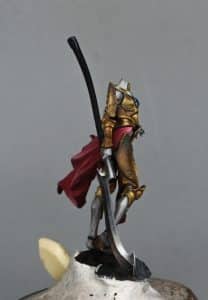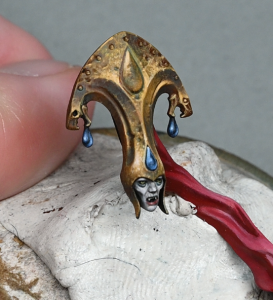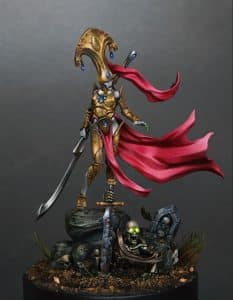How to Paint a Vampire Lord from the Soulblight Gravelord Armies! This includes NMM shiny steel armour, face and hair, skeleton base tutorial plus a dripping gore-covered mace! Read on to watch the comprehensive set of How to Paint a Vampire Lord tutorials plus key steps, paints and materials guide.
Quick Jump to:
Video – How to Paint a Vampire Lord Steel Armour
Paints and Materials
Paints:
- Vallejo Neutral Grey: Used for mapping out highlights and base tones on the armour.
- Vallejo Ice Yellow: Applied for initial highlights, gives a warm, off-white effect.
- Games Workshop Mournfang Brown: Used sparingly for adding depth and richness in transitions.
- Games Workshop Abaddon Black: Thinned down and used for glazing to deepen shadows and smooth transitions.
- P3 Morrow White: For final bright highlights. Thinned down considerably for a subtle effect.
Brushes:
- Fine Detail Brushes: Essential for applying precise highlights and for the stippling technique. I used the Artis Opus range, but any high-quality fine brush will work.
- Glazing Brushes: Preferably also with a fine tip, used for applying thinned down glazes of Mournfang Brown and Abaddon Black.
Primer:
- Ultimate Primer (Black): Used for priming the model before painting.
Step-by-Step Guide and Tips for the NMM Armour
Preparation: Assemble the model but avoid gluing areas like the shield or head that might obstruct painting. Prime the model in black. For this, Ultimate Primer is a good choice.
Base Layer: Start with Vallejo Neutral Grey to map out highlight points on the armour. This colour is ideal for desaturated, steel-like effects.
Light Direction and Armour Detailing: Consider the light source and how it hits the model. Focus on areas like the hip covers and rib cage, and map out light and reflections. The Neutral Grey will be useful for creating the base tones.
Initial Highlights: Apply Vallejo Ice Yellow for the highlights. Despite its name, Ice Yellow will give a desaturated, warm white appearance, especially when applied thinly. This is perfect for adding a subtle warmth to the steel.
Refining the Highlights: Use a stippling technique with Neutral Grey and Ice Yellow, building up the texture and refining the highlights. Remember, this is a gradual process, and patience is key.
Adding Depth with Mournfang Brown: Introduce Games Workshop Mournfang Brown sparingly at transition edges or darker areas for a richer tone. Be cautious not to overdo it, as too much brown can detract from the steel effect.
Glazing for Smoothness: Thin down Mournfang Brown and Abaddon Black with water (about 5-6 parts water to 1 part paint) and apply them as glazes. This step will help in smoothing out transitions and adding depth.
Final Highlights with Morrow White: Use P3 Morrow White for final bright highlights. Ensure the white is thinned down and apply it very carefully to the highest points of the armour.
Adjusting and Blending: Keep adjusting the highlights and shadows, blending the colours where necessary. This might involve going back and forth between the different shades to achieve a smooth transition.
Finish and Review: Once satisfied, review the model under different lighting to ensure the non-metallic metal effect is consistent and realistic.
Throughout this process, keep your paint thin and apply multiple layers for the best results. The key to NMM is patience and gradual building of layers. Remember, each step contributes to the overall metallic effect, so take your time and enjoy the process!
Video – How to Paint a Vampire NMM Shield
Paints and Materials
Games Workshop: Mournfang Brown, Abaddon Black, Mephiston Red, Balor Brown
Vallejo: Neutral Grey, Ice Yellow
P3: Morrow White
Step-by-Step Guide and Tips for the NMM Shield
Priming and Preparation:
The shield should be primed black. The use of Ultramar Varnish is optional.
Base Layering:
Start with Vallejo Neutral Grey, using scribbly strokes to create a rough and scratchy base.
Add a darker grey mixture by blending Neutral Grey with Abaddon Black. This can be substituted with other dark greys like Vallejo German Grey.
Creating Texture:
Continue with Neutral Grey, making irregular, scratchy marks. These marks will contribute to a subtle textured look.
Focus on building up layers and refining the texture.
Highlighting:
Apply a mix of Neutral Grey and Ice Yellow for initial highlights.
Move to Ice Yellow, applying it thinly (1.5 parts water to 1 part paint) to avoid a chalky finish.
Apply the Ice Yellow in a stippling manner to refine the highlights and cover uneven areas.
Painting the Dragon:
Base the dragon with Mephiston Red.
Create shadows by adding a small amount of Abaddon Black to Mephiston Red.
For highlights, mix Mephiston Red with P3 Morrow White (or another white) and apply to raised areas and facets of the dragon
Glazing and Refining:
Use a heavily diluted mixture of Mournfang Brown, Abaddon Black, and P3 Morrow White for glazing.
Apply the Mournfang Brown for a soft yellow-brown hue in certain areas.
Use Abaddon Black to darken and dull areas and to create shadows.
Use P3 Morrow White to soften and blend the highlighted areas.
Adding Scratches and Imperfections:
Add random scratch-like marks using a very light application for realism.
Apply small white dots to suggest nicks and imperfections.
Final Highlights and Adjustments:
Go over the shield and dragon, adding final highlights and making adjustments as necessary.
Focus on achieving a balanced look from different viewing angles.
Painting the Trim: Paint the trim using a mix of Abaddon Black and Mephiston Red as a base.
Layer with Balor Brown, and then add highlights with a mix of Balor Brown and Mournfang Brown.
Add final edge highlights and details to match the overall lighting and contrast of the shield.
Finishing Touches:
Tidy up any rough edges or over-painted areas.
Ensure that the shield’s various sections harmonize in terms of light and contrast.
Remember to let each layer dry thoroughly before applying the next, and adjust the thickness of your paints with water to maintain control and avoid a textured buildup.
Video – Non Metallic Metal Mace with added Gore
Paints and Materials
- Primer: Black
- Paints:
- Vallejo Neutral Grey
- Vallejo Black
- Vallejo Basalt Grey
- Vallejo German Grey
- Games Workshop Rhinox Hide
- Games Workshop Blood for the Blood God
- P3 Morrow White
- Brushes: Fine detail brushes
- Additional: Gloss varnish, super glue, fishing wire for gore effect
Step-by-Step Guide and Tips for the Gory Mace
- Priming: The mace should be primed in black.
- Base Layering:
- Start with Vallejo Neutral Grey. This can be created with a mix of black and white.
- Use Pearl Grey Blue for slight colour variation, though this is optional.
- German Grey can also be added to the mix.
- Highlighting and Texture:
- Focus on picking out angles and curves on the mace.
- Ensure brighter parts on surfaces facing you, with darker shades on less visible parts.
- Use a combination of different greys to build up layers and create a realistic metal effect.
- Detailing:
- Pay attention to the many facets of the mace, including chamfered edges and curves.
- Use fine brushes for precision in highlighting these small, detailed areas.
- Glazing:
- Mix Rhinox Hide with a significant amount of water for a thin glaze.
- Apply this to mid-tones to shadows, avoiding the brightest highlights.
- This step enhances contrast and adds a hint of colour to the mace.
- Adding the Gore Effect:
- Attach thin strands of fishing wire to the mace using super glue to create dangling gore.
- Apply gloss varnish to the connection points for added strength and flexibility.
- Once the varnish is dry, cover the fishing wire with “Blood for the Blood God” paint.
- Ensure the gore effect is applied in a realistic manner, considering where blood would naturally accumulate and drip from the mace.
- Final Touches:
- Revisit any areas that need refining or additional highlights.
- Make sure the gore effect blends seamlessly with the painted mace.
- Allow all layers to dry completely before handling.
Tips:
- Take your time with each facet of the mace; precision is key to a realistic look.
- Ensure your paint consistency is right for each step – thinner for glazing, thicker for opaquer details.
- Be cautious when applying the gore effect; it’s a focal point but shouldn’t overwhelm the detailed painting beneath.
Video – Vampire Lord Face and Hair
Paints and Materials
Games Workshop: Calgar Blue, Cadian Fleshtone, Ushabti Bone, Yriel Yellow, Khorne Red, Mephiston Red
Vallejo: Neutral Grey, Black
Step-by-Step Guide and Tips for the Face and Hair
Painting the Face:
Base Coat: Start with a base coat of Calgar Blue over the black primer. Expect poor coverage initially. Thin the paint with approximately 1.5 parts water to 1 part paint. Apply 3-4 layers to achieve an opaque finish.
Highlighting: Create a mix of 50/50 Calgar Blue and Cadian Fleshtone. Apply this mix to specific areas of the face, considering the natural light fall. Key areas include the forehead, cheekbones, and areas between the eyes and nose. This mix will start to give a flesh tone, retaining a hint of blue for the undead look.
Further Detailing: Use Cadian Fleshtone and a mix of 50/50 Ushabti Bone and Cadian Fleshtone for additional highlighting. Focus on raised areas and consider how light interacts with facial features. Apply highlights gradually, using a heavily diluted mix for soft transitions.
Eyes and Mouth: Paint the eyes and the inside of the mouth in black. This step ensures these areas are defined and helps balance the highlights on the face.
Painting the Hair:
Base Coat: Apply Neutral Grey from Vallejo over the black primer. Switch to Khorne Red for a vibrant, contrasting colour to the skin. Thin the paint slightly and apply multiple coats for an even, opaque finish.
Highlighting: Use Ushabti Bone to highlight the hair. Mix it with Khorne Red in varying proportions, increasing the Ushabti Bone content for brighter highlights. Focus on areas where light would naturally hit, creating a shiny, luxurious look.
Glazing for Colour Depth: After highlighting, the hair may appear too desaturated. To bring back the richness of the red, glaze over the hair with a heavily diluted Mephiston Red. This step enhances the red colour while maintaining the shine.
Final Touches on Hair: Optionally, add Abaddon Black to the corn red to create darker shades in the hair, increasing the depth and contrast.
Video – Skeleton Base Part One
Paints and Materials
- A skeleton figure from Warhammer Underworlds Warbands
- Milliput and Fimo (or slate pieces)
- Green stuff (50/50 mix of blue and yellow)
- Super glue
- Sand (variety in particle size, not sharp sand)
- PVA glue (diluted with water)
- Base brush (flat Games Workshop brush or equivalent)
- Neutral Grey (Vallejo), Deathworld Forest, Morghast Bone, Agrax Earthshade, Athonian Camoshade, Astronomicon Grey (Games Workshop)
- Water for thinning paints
Rock material guide by the fantastic Julien Casses:
https://www.juliencasses.com/2012/11/how-to-make-rocks
Step-by-Step Guide and Tips for the Skeleton Base
Building the Base
- Prepare Skeleton: Start by preparing your skeleton figure, ensuring it has a ‘rising from the ground’ appearance.
- Create Stone Slabs: Mix Milliput and Fimo, bake at 120°C for 30 minutes, then break into slabs to represent stones. Alternatively, use slate pieces. Attach these slabs to the base with super glue.
- Apply Green Stuff: Mix blue and yellow Green Stuff and use it to create a ridge around the skeleton, giving the illusion of a hole from which the skeleton emerges. Embed the Vampire Lord’s rock into the Green Stuff to integrate it with the base.
- Add Texture: Sculpt some small, round rocks using Green Stuff for added detail.
- Sand Application: Cover the base in beach sand, avoiding sharp sand. Use various particle sizes for a natural look.
Painting the Base
- Seal Sand: Brush diluted PVA glue over the sand to seal it and prevent flaking.
- Base Colour for Sand: Dry brush the entire base with Deathworld Forest, focusing on sandy areas.
- Highlighting Sand: Apply a lighter dry brush of Morghast Bone to the sand for highlights.
- Defining Rocks: Use Agrax Earthshade as a thick glaze around the sculpted rocks to define their shapes.
- Enhancing Greenery: Apply Athonian Camoshade to enhance the green tones on the base.
- Rock Painting: Begin detailed painting on rocks using Neutral Grey. Focus on highlighting angles and adding scratchy details for texture.
- Additional Rock Highlights: Use Pelgrave Blue, potentially mixed with white, to highlight rocks further. Remember not to overpower the model with the base’s contrast.
- Enhancing Edges: Add lighter edges around rocks using Astronomicon Grey to define shapes.
Finishing Touches
- Consider adding other details like small flowers or greenery to the base.
- Reflect these colours onto the Vampire Lord for cohesion.
- Ensure the base matches the quality and style of your painted model.
Video – Skeleton Base Part Two (Painting the Skeleton)
Paints and Materials
- Paints: XV-88, Balor Brown, Moot Green, Deathworld Forest, Ushabti Bone, Mournfang Brown, Trollslayer Orange (Games Workshop); Neutral Grey, Pale Grey Blue, Black (Vallejo); Iosen Green, Morrow White (P3)
- Mininatur Moss Pads and Flowers
- Water for thinning paints
- Brushes with fine tips
- PVA Glue
- Jeweler’s tweezers
Step-by-Step Guide and Tips for Painting the Skeleton Base
Painting the Skeleton
- Eyes: Start by painting the eye sockets with white paint, thinned down. Apply 2-3 layers for an opaque finish. Avoid overloading to prevent the paint from pooling.
- Adding Color to Eyes: Use Pro Acryl Golden Yellow (or any similar yellow) around the edges of the eye sockets, leaving the back white to mimic a light source. Then, use Moot Green, thinned down, around the yellow, ensuring smooth transitions.
- Skeleton Bone: Use XV-88 to paint the skull and bones. Apply the paint thinly and unevenly to create a natural, weathered look. Emphasize areas where light would naturally hit, based on the light source direction.
- Highlighting Bone: Apply Ushabti Bone for highlights, focusing on raised areas and edges. Keep the paint thin for a smooth finish.
- Additional Details: Add small scratches or battle damage marks for realism.
- Final Highlights on Bone: Use white (Morrow White) for the final highlights on the most raised areas.
Painting the Sword
- Base Colour: Use Neutral Grey to paint the entire sword, including the hilt and blade.
- Weathering: Add Mournfang Brown to the blade for a rust effect, focusing on recessed areas and pitted holes.
- Highlighting the Blade: Use Pale Grey Blue for highlighting and adding scratchy details, focusing on areas that would catch light.
- Rust Details: Add Trollslayer Orange in the deepest recesses for an inverted highlight effect.
- Refining Highlights: Go back with Neutral Grey and Pale Grey Blue to refine the highlights and add more detail to the weathered look.
Painting the Cloth
- Base Layer: Apply Deathworld Forest over black primer, focusing on raised folds and areas that would catch light.
- Highlighting: Use Balor Brown for further highlights, keeping the paint very thin to maintain a dark, grubby appearance.
Adding Vegetation
- Applying Moss Pads: Use PVA glue to attach Mininatur Moss Pads around the base. Utilize jeweler’s tweezers for precise placement.
- Adding Flowers: Integrate white flowers from Mininatur for additional detail. Trim if necessary to avoid overpowering the base.
- Adding Roots: For an emerging effect, glue small roots around the skeleton, bending them to create a natural look.
- Dry Brushing: Gently dry brush Balor Brown over the moss pads to integrate them with the base and add depth.
Video – Simple Freehand Dragon
Paints and Materials
The following paints were used:
Games Workshop: Rhinox Hide, Mournfang Brown
Vallejo: German Grey, Neutral Grey, Ice Yellow, White
Step-by-Step Guide and Tips for the Freehand Dragon
- Prepare the Surface: Begin by roughly painting the inside of the shield with a mixture of Mournfang Brown and Rhinox Hide from Games Workshop. These paints should be heavily thinned with approximately two parts water to one part paint. Use a large brush, like a size 2 artist opus brush, for quick and broad coverage. This base coat doesn’t need to perfectly match the shield’s front colour, as it will largely be covered.
- Apply Texture: The texture on the back of the shield differs from the front to differentiate it from the armor. Apply the paint in a scratchy manner to simulate wear and tear. For this, use Neutral Grey from Vallejo, mixed with Ice Yellow for highlights, and German Grey for darker areas. Remember, this part doesn’t have to be perfectly blended, as some roughness adds character.
- Glazing: If needed, glaze over the scratchy texture with more diluted Rhinox Hide and German Grey. Glazing helps to soften the texture and can hide any imperfections in the painting.
- Freehanding the Dragon: When painting the dragon, start with a reference photo of the dragon design on the shield’s front. This helps maintain consistency across the model. Use Vallejo Model Color Black for the dragon outline, ensuring the paint is well-diluted for fine lines.
- Brush Selection: Use a fine brush for detailed work. A worn-out brush might not give the sharp lines needed for intricate details. A newer, sharper brush is recommended for finer details and corrections.
- Highlighting the Dragon: Start with Neutral Grey for initial highlights. For more pronounced highlights, mix Neutral Grey with Ice Yellow, leaning more towards Ice Yellow for brighter highlights. Apply these highlights only to the upper edges of the dragon design, where light would naturally catch.
- Adjusting for 3D Effect: Paint the inside of the dragon with a darker grey, such as a mix of German Grey and Neutral Grey, to create depth and avoid a flat black appearance.
- Final Touches: Add fine highlights to the dragon, especially along the edges and raised areas, to enhance the 3D effect. Use a mix of Neutral Grey and Ice Yellow, and pure Ice Yellow for the brightest points. Be mindful of the shield’s orientation to ensure that highlights correspond to the light source.
- Painting the Shield Trim: Finally, paint the shield’s trim, likely in a gold or metal colour. This trim frames the dragon and gives a polished look to the shield, enhancing the overall appearance.
More Vampire Tutorials!
If you don’t have an account, please sign up here! The website currently has over 350 video tutorials with steps and tips, plus a selection of PDFs. If you are not sure about joining, you can explore my free videos with a free membership, or take the plunge and become a full subscriber for full access.
If you’d prefer to support me on Patreon, please visit: https://www.patreon.com/RichardGray





